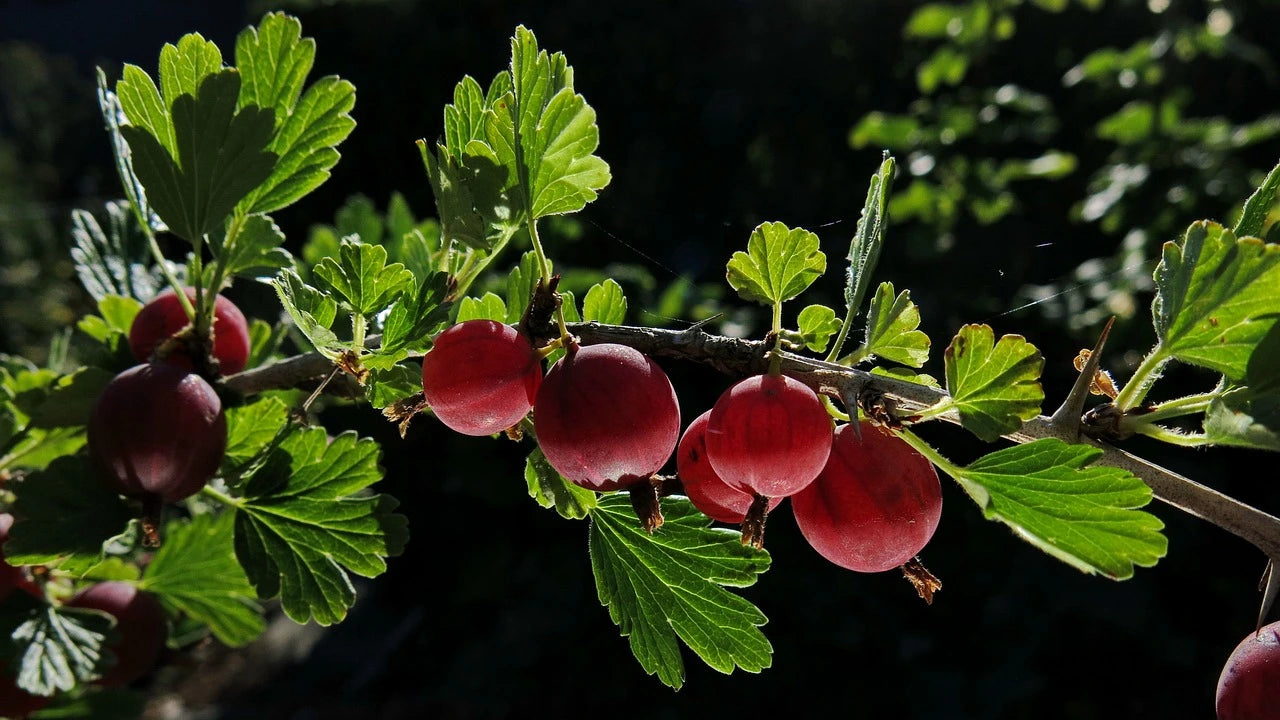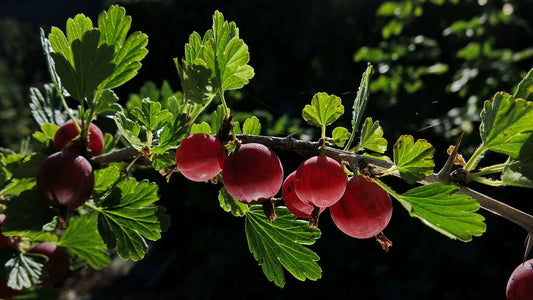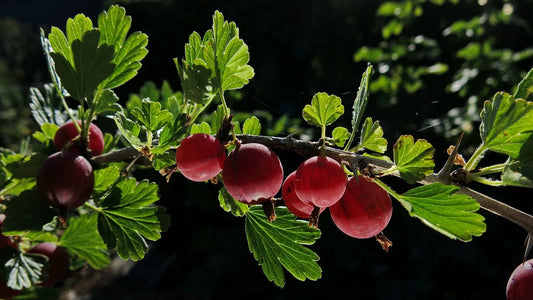-
Delivery from 10 plants within 15 days FR/ EU / CH
Delivery Terms -
Wholesale Supplier of Small Fruit Plants
About Us -
Quality Small Fruit Plants
Technical itinerary for small fruits -
Secure payment
Our Payment Terms
GOOSEBERRY plant Ladya Delamare ORGANIC - 9 cm pot
GOOSEBERRY plant Ladya Delamare ORGANIC - 9 cm pot
Price € excluding VAT per unit excluding transport. Our prices are based on volume. We offer you the best option based on your needs.
Couldn't load pickup availability
 Buy now and get it delivered when you're ready to plant - Add your desired date to your quote request
Buy now and get it delivered when you're ready to plant - Add your desired date to your quote request
 Delivery from 10 plants within 15 days FR/ EU / CH
Delivery from 10 plants within 15 days FR/ EU / CH
This plant is a small fruit plant in a 9 cm pot
This small fruit plant is stored in a 9 cm square horticultural pot. These plants are robust because they are more mature than the majority of plants in the range (smaller pot or bare-root). The pot packaging allows the plant to store water and nutrients and thus allows storage before planting in the ground. However, excessive storage should be avoided to prevent the roots from twisting, which would reduce the plant's ability to recover.
These small fruit plants for professionals are certified organic AB
Buying professional organic berry plants from AB allows you to produce organically. Fruits can be sold organically.
When to Plant / When to Harvest Gooseberry Bushes?
Do you want to grow gooseberries but don't know when to plant them? Do you want to know when you'll harvest them? Check out our Gooseberry Planting and Harvesting Calendar
View full details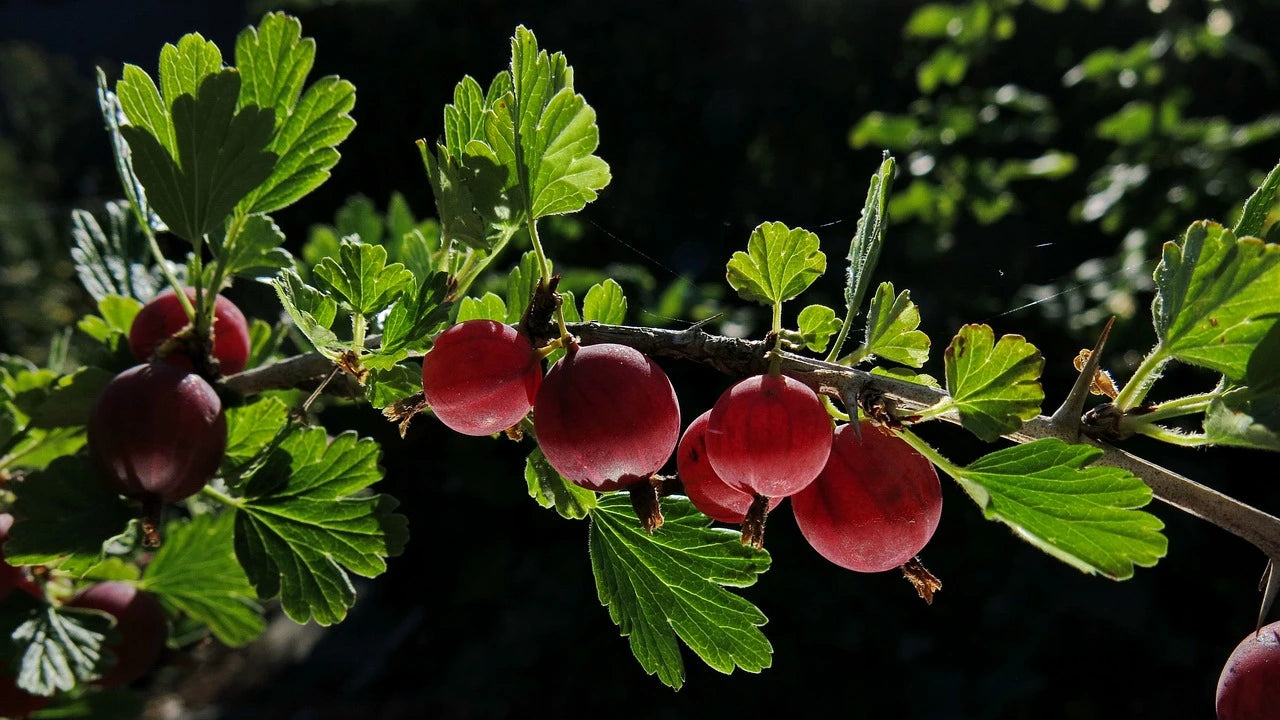
Our quality gooseberry bushes for professional market gardeners
Quick read / the essentials on Gooseberries
The gooseberry bush is gradually establishing itself as a strategic diversification crop for fruit professionals in France. Resilient, productive and appreciated for its taste and nutritional qualities, it appeals to market gardeners looking for agricultural solutions with high added value. Bairiverse , a specialist wholesale supplier of small fruit plants , supports this dynamic by offering a complete range of gooseberry plants, adapted to the requirements of professionals. Whether you are looking to diversify your range, intensify your short supply chains or meet the growing demand from processors, buying gooseberry plants from a reliable partner is a guarantee of success.
The gooseberry plants offered by Bairiverse , a specialist wholesale supplier of small fruit plants , are available in different forms: in horticultural pots, in mini-plugs, in 1 to 4 liter pots, in bare roots or ready to repot. These formats cover all the needs of nurserymen, horticulturists and producers involved in planting projects in the open ground, in orchards or in peri-urban areas. Our plants are suitable for both conventional cultivation and certified organic or untreated production.
Buying gooseberry plants means investing in a crop that is suited to a temperate climate, short cycles, and whose outlets are multiplying: artisanal jam, juice, food processing or direct sales. Thanks to our optimized logistics and dedicated technical support, Bairiverse , a specialist wholesale supplier of small fruit plants , helps you to sustainably implement this crop in your agricultural strategy. Choose a committed partner to successfully purchase gooseberry plants .
Introducing our range of gooseberries
Bairiverse, a specialist in small fruit plants for professionals, offers a wide range of gooseberry plants for market gardeners and nurserymen. Our plants are available in organic, conventional, and untreated varieties to meet the requirements of demanding growers. We offer:
- Wide range of gooseberry plants in 7, 8 and 9 cm horticultural pots, perfectly suited to sale in garden centers or for delayed planting
- Wide range of gooseberry plants in mini-plugs packaged in trays of 77 units, for mechanized planting or high densities
- Wide range of gooseberry plants in 1 to 4 litre pots for easy planting and good root development
- Wide range of bare-root gooseberry plants for high-volume autumn and winter planting
- Wide range of gooseberry plants ready to repot, for professionals wishing to control their marketing stage
Our catalog includes professional-quality gooseberry plants, available year-round, adapted to French climatic conditions and various uses (fresh, processed, direct sales). All our plants are available for delivery directly to your farm with personalized technical support.
Gooseberry cultivation in France
Analysis of the Gooseberry Market in France (2022-2025)
The gooseberry market is part of the general growth dynamic for small fruits, with strong valuation on a European and global scale. It represents a real diversification opportunity for French producers.
Market Evolution and Economic Trends
The global gooseberry market is estimated at USD 1.54 billion in 2024, with a projection of USD 1.92 billion by 2029. Europe accounts for 90% of global production, reinforcing the strategic role of the French sector.
Distribution Channels
Direct sales are growing significantly: from 5.6% in 2019 to 12.6% in 2022. Garden centers and LSA are losing ground, while producers are taking an increasing place in distribution channels.
Consumption and Demand
French imports of berries increased by 743% between 2003 and 2023. Gooseberries are enjoying renewed interest for their nutritional qualities (vitamin B6, minerals, antioxidants) and their authentic taste.
Sector Structure and Sought-After Varieties
French nurseries are mostly in good financial health. Among the most popular varieties:
- 'Pixwell', 'White Smith', 'May Duke'
- 'Hinnonmaki rouge' and 'Invicta', resistant to powdery mildew
Outlook for Plant Suppliers
Strengthening the variety offering, disease resistance, and certified organic production are levers for meeting growing demand.
Our sales arguments
Delivery designed for gooseberry growers
- Delivery to your plot or farm
- Delivery possible within 15 days throughout France and Europe
- Careful delivery with tailgate option for easy unloading
Technical support dedicated to gooseberry cultivation
- Responsive sales service: quote within 48 hours
- Personalized technical advice and specific itineraries
- Technical support provided throughout the project
A complete and competitive offer
- Organic, conventional or untreated gooseberry plants
- Wide range of varieties available all year round
- Producer prices with decreasing rates according to volumes
- The widest range of small fruit plants in pots, alveoli, pots and bare roots
Bairiverse supports you in setting up or diversifying your gooseberry cultivation, with a comprehensive offer adapted to the requirements of professional producers.
General Presentation of Gooseberry Bushes for Professionals in France
Gooseberry (Ribes uva-crispa) is emerging as a promising niche fruit crop, gradually regaining the attention of agricultural professionals in France. Its appeal lies both in its nutritional qualities and its potential for agri-food processing. This fact sheet aims to provide an overview of the sector, exploring production conditions, agronomic requirements, market opportunities, and economic prospects.
Context and Trends of the French Market
Gooseberry cultivation in France represents a modest but dynamic part of fruit horticulture. In 2023, the country had between 100 and 150 hectares under cultivation, with an estimated production of between 800 and 1,000 tonnes. This production remains confidential, but the renewed interest in “superfruits” and artisanal processed products is stimulating moderate but steady growth.
The wholesale price ranges from 6.87 to 12.36 USD/kg , with a market valued at between 5.5 and 12.3 million euros per year. Interest is particularly driven by processors , who use gooseberries in high value-added products: jams, jellies, juices, pastries and even liqueurs.
Agronomic Interests and Benefits of Cultivation
- Adapted to temperate climates with cold winters and moderate summers.
- Moderate resistance to some diseases and pests.
- Increased profitability on small surfaces thanks to artisanal processing.
- Excellent promotion in short circuits and organic farming.
- Positive role in the diversification of orchards or specialized crops.
Choosing a Location and Preparing the Soil
The choice of site is essential: sunny exposure to the north, partial shade to the south. Avoid frost-prone areas. The soil must be well-drained, with an ideal pH between 6.0 and 6.5 .
Recommended preparation:
- Deep plowing in autumn (30-40 cm).
- Incorporation of organic matter (manure/compost: 40-50 t/ha).
- Basic fertilization (phosphorus, potassium, magnesium).
- Drainage or planting on mounds in areas with excess water.
Planting and Density
Planting is done in autumn (Oct.-Nov.) or early spring (Feb.-May) .
Recommended spacing:
- Hand-cultivated: 1.0–1.25 m between plants, 2.0–2.5 m between rows.
- Mechanized cultivation: rows spaced 3.0–3.5 m apart.
- Density: 3000 to 4000 plants/ha.
Irrigation and Fertilization
Irrigation:
- Drip preferred for its effectiveness (90-95%).
- Weekly contributions of 25-30 mm during the growth phase.
Fertilization:
- Conventional: Balanced NPK rich in K, nitrogen splitting.
- Organic: compost, beet vinasse, organic fertilizers, bone meal.
Pruning and Training
Size :
- Training for the first 3 years (10-12 main branches).
- Annual maintenance: removal of old wood, thinning.
Training:
- Optional but beneficial:
-
- +15-25% yield.
- 20-30% reduction in harvest time.
- Best fruit quality.
Pollination
Although varieties are mostly self-fertile , cross-pollination can improve yields by 15-20%.
Advice :
- Plant two different varieties <30 m apart.
- Install 2 to 3 hives/ha.
- Encourage pollinators with honey-producing hedges and flower strips.
Fight against Weeds, Diseases and Pests
Weeds: mulching, manual/mechanical weeding, mowing.
Diseases :
Powdery mildew, anthracnose: prevention by pruning and sulfur/copper in organic farming.
Pests: aphids, mites → black soap, neem oil, specific treatments.
Protection Against Climatic Hazards
Frost: spraying, antifreeze candles, antifreeze towers, helicopters.
Drought: drip irrigation, mulching, windbreaks.
Excess water: drainage, infiltration ditches, planting on mounds.
Harvest and Post-Harvest
Period: end of June to mid-August depending on the region.
Method :
Manual harvest, in 2-3 passes.
Use of gloves recommended.
Yield :
1.5 to 3 kg/plant, 8 to 12 tonnes/ha.
Conservation :
Sort and cool to 2-4°C within 2 hours.
Store at 0-1°C for up to 3 weeks.
Can be frozen for up to 12 months.
Performance and Profitability
Full yield from the 3rd year.
Average annual production: 7000 to 10,000 kg/ha .
Productivity per adult plant: 2 to 4 kg/year .
To summarize: Gooseberries
In conclusion, the gooseberry bush represents a crop of the future, particularly relevant for French producers looking for an original, profitable fruit that can be used in short supply chains or artisanal processing. Thanks to its agronomic qualities (climate adaptability, yield, varietal diversity), it finds its place in modern farms. To succeed in your project, it is crucial to buy gooseberry plants from a recognized player such as Bairiverse , a wholesale supplier specializing in small fruit plants .
Our gooseberry plants, available year-round in a variety of packaging, meet the highest professional standards. Whether you're looking for plants in pots, cells, bare roots, or pots, our range adapts to your planting requirements, whether organic, conventional, or untreated. Buying gooseberry plants from Bairiverse means benefiting from consistent quality, expert technical service, and logistics designed for farmers, with fast delivery throughout France.
Because each project is unique, Bairiverse , a specialist wholesale supplier of small fruit plants , supports you every step of the way: choice of varieties, advice on planting, cultivation itinerary, technical monitoring. With its expertise in the small fruit market, Bairiverse positions itself as a strategic partner for purchasing gooseberry plants with complete confidence. Give your farm a new lease of life with a species with high potential and plants with high agronomic value.
-
Hinnonmaki-Röd bare-root gooseberry plant 1 branch
Regular price €0,72 EURRegular priceUnit price / per -
Gooseberry plant bare-root Hinnonmaki-Grön plant 1 branch
Regular price €0,72 EURRegular priceUnit price / per -
Gooseberry plant bare-root Mucurines plant 1 branch
Regular price €0,72 EURRegular priceUnit price / per -
Gooseberry plant Hinnonmäki Röd Organic - Rooted cutting, height 40–50 cm
Regular price €0,73 EURRegular priceUnit price / per
Additional / Useful information:
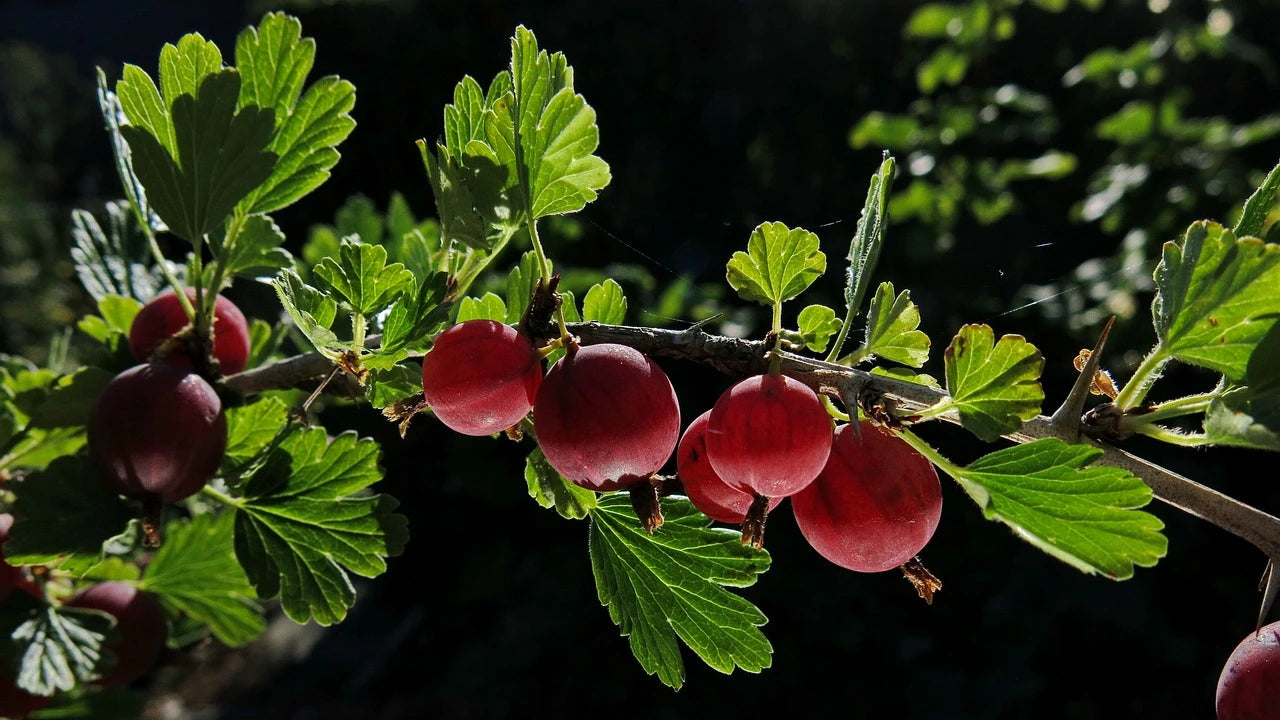
Which variety of gooseberry should you choose? Characteristics and uses of gooseberries
How to choose your gooseberry variety?
Are you looking to plant gooseberries on your plot but don't know which gooseberry variety to choose? This gooseberry variety guide lists the main varieties along with their characteristics and uses. For farm sales, supermarket sales, or processing? There's something for everyone.
If you are looking for another variety of Gooseberry , please do not hesitate to contact us: contact us
Our ranges of Gooseberry Bushes :
Organic Gooseberry Range for Professionals
Conventional Gooseberry Range for Professionals
Gooseberry Variety Guides:
| Variety | Fruit Color | Remontante | Precocity | Productivity | Fruit Size / Shape | Disease Resistance / Hardiness | Fruiting Period | Taste | Self-fertile |
|---|---|---|---|---|---|---|---|---|---|
| Achilles | Smooth purple-red skin | Non-Rising | Season | Large production but medium-sized fruit | Elongated fruit, very large fruits | Susceptible to mildew | July to August | Very suitable for fresh consumption. Very aromatic and sweet taste. | Self-fertile variety |
| Captivator | Red | Non-Rising | Early | Very productive variety | Medium and round size | Few thorns. Very resistant to mold. Very hardy and vigorous variety. | End of June to mid-July | Very sweet. Perfect for making jam or wine. | Self-fertile variety |
| Hinnonmaki-Röd | Dark red | Non-Rising | Mid-Late | Variety offering a high yield. Between 4 and 5 kg per plant when mature. | Fairly large berries. Round | Vigorous. Frost resistant but drought tolerant. Good resistance to powdery mildew. | End of July to mid-August | Good sweet and sour taste. Juicy. Fresh taste. Slightly acidic. Can be eaten fresh or processed. In jellies, pies or as an accompaniment to meat dishes. | Self-fertile variety |
| Hinnonmaki-Grön | Pale Green | Non-Rising | Late | High yield. Up to 4 kg per plant when fully grown. | Medium-sized berries. Fairly firm. | Frost resistant | Beginning to End of August | Fine taste and suitable for all uses (fresh, processed). Milder and sweeter than Hinnonmaki-Röd | Self-fertile variety |
| Hinnonmaki-Gül | YELLOW | Non-Rising | Season | Classic yield. Slightly lower than Grön and Röd | Medium-sized variety | Vigorous and disease-resistant variety | Start to End of July | Very sweet and fragrant | Self-fertile variety |
| Invicta | Greenish-yellow | Non-Rising | Mid-Season | High-yielding variety. Up to 5 kg yield per plant at maturity. | Large yellow fruits. Translucent yellowish flesh. | Variety resistant to mildew. Very resistant to powdery mildew. | July to August | Very fragrant. Sweet and tangy taste. Perfect for jelly and jam. | Self-fertile variety |
| Mucurins | Greenish-yellow | Non-Rising | Season | High yielding variety | Fruit of relatively large size | Mildew resistant variety | Start to End of July | Mild tasting variety. Tangy and aromatic. | Self-fertile variety |
| Whinham's Industry | Dark to purple gnawing | Non-Rising | Mid-Early | High yield, up to 4KG per plant at maturity | Large, elongated fruits | Variety slightly susceptible to mildew. Sensitive to drought. | End of June to mid-July | Very tasty, fresh, slightly sweet. Widely used in processing for jam, jelly or as an accompaniment to fish or meat. | Self-fertile variety |
| Whitesmith | White-Green | Non-Rising | Season | Very productive variety. Easy to pick. | Fruit of fairly large size | Variety susceptible to mildew. Hardy variety. Good resistance to cold. | Mid-July | Excellent taste. One of the best-tasting varieties on the market, highly valued for this quality. Can be used in compote, fish or meat accompaniment, or jam. | Self-fertile variety |
Which variety of gooseberry should you choose? Characteristics and uses of gooseberries
How to choose your gooseberry variety?
Are you looking to plant gooseberries on your plot but don't know which gooseberry variety to choose? This gooseberry variety guide lists the main varieties along with their characteristics and uses. For farm sales, supermarket sales, or processing? There's something for everyone.
If you are looking for another variety of Gooseberry , please do not hesitate to contact us: contact us
Our ranges of Gooseberry Bushes :
Organic Gooseberry Range for Professionals
Conventional Gooseberry Range for Professionals
Gooseberry Variety Guides:
| Variety | Fruit Color | Remontante | Precocity | Productivity | Fruit Size / Shape | Disease Resistance / Hardiness | Fruiting Period | Taste | Self-fertile |
|---|---|---|---|---|---|---|---|---|---|
| Achilles | Smooth purple-red skin | Non-Rising | Season | Large production but medium-sized fruit | Elongated fruit, very large fruits | Susceptible to mildew | July to August | Very suitable for fresh consumption. Very aromatic and sweet taste. | Self-fertile variety |
| Captivator | Red | Non-Rising | Early | Very productive variety | Medium and round size | Few thorns. Very resistant to mold. Very hardy and vigorous variety. | End of June to mid-July | Very sweet. Perfect for making jam or wine. | Self-fertile variety |
| Hinnonmaki-Röd | Dark red | Non-Rising | Mid-Late | Variety offering a high yield. Between 4 and 5 kg per plant when mature. | Fairly large berries. Round | Vigorous. Frost resistant but drought tolerant. Good resistance to powdery mildew. | End of July to mid-August | Good sweet and sour taste. Juicy. Fresh taste. Slightly acidic. Can be eaten fresh or processed. In jellies, pies or as an accompaniment to meat dishes. | Self-fertile variety |
| Hinnonmaki-Grön | Pale Green | Non-Rising | Late | High yield. Up to 4 kg per plant when fully grown. | Medium-sized berries. Fairly firm. | Frost resistant | Beginning to End of August | Fine taste and suitable for all uses (fresh, processed). Milder and sweeter than Hinnonmaki-Röd | Self-fertile variety |
| Hinnonmaki-Gül | YELLOW | Non-Rising | Season | Classic yield. Slightly lower than Grön and Röd | Medium-sized variety | Vigorous and disease-resistant variety | Start to End of July | Very sweet and fragrant | Self-fertile variety |
| Invicta | Greenish-yellow | Non-Rising | Mid-Season | High-yielding variety. Up to 5 kg yield per plant at maturity. | Large yellow fruits. Translucent yellowish flesh. | Variety resistant to mildew. Very resistant to powdery mildew. | July to August | Very fragrant. Sweet and tangy taste. Perfect for jelly and jam. | Self-fertile variety |
| Mucurins | Greenish-yellow | Non-Rising | Season | High yielding variety | Fruit of relatively large size | Mildew resistant variety | Start to End of July | Mild tasting variety. Tangy and aromatic. | Self-fertile variety |
| Whinham's Industry | Dark to purple gnawing | Non-Rising | Mid-Early | High yield, up to 4KG per plant at maturity | Large, elongated fruits | Variety slightly susceptible to mildew. Sensitive to drought. | End of June to mid-July | Very tasty, fresh, slightly sweet. Widely used in processing for jam, jelly or as an accompaniment to fish or meat. | Self-fertile variety |
| Whitesmith | White-Green | Non-Rising | Season | Very productive variety. Easy to pick. | Fruit of fairly large size | Variety susceptible to mildew. Hardy variety. Good resistance to cold. | Mid-July | Excellent taste. One of the best-tasting varieties on the market, highly valued for this quality. Can be used in compote, fish or meat accompaniment, or jam. | Self-fertile variety |
French gooseberry market in 2025
Gooseberry (Ribes uva-crispa), a shrub native to the Caucasus and northern Ukraine, is a popular choice for its tangy berries, which have multiple culinary uses and nutritional benefits. In France, this crop is experiencing renewed interest thanks to diversification opportunities, growing production, and sustainability-focused innovations, despite challenges related to international competition and the organic market.
Presentation and commercial uses
Gooseberry (Ribes uva-crispa) is a thorny shrub native to the Caucasus and northern Ukraine, growing between 50 cm and 1.5 metres in height . Its fruits, called gooseberries, are oval berries 1.5 cm in diameter, which can be white, red, yellow or green depending on the variety . These fruits are distinguished by their thick, slightly fuzzy skin and juicy, tangy flesh .
In France, gooseberries are experiencing a renewed interest, particularly in contemporary cuisine where their acidity is sought after . Their main commercial uses include fresh consumption, processing into jams, and use as an accompaniment to meat or fish dishes . Additionally, these berries are valued for their nutritional benefits, being rich in vitamins C, A and B, as well as minerals such as calcium and potassium . Their low sugar content and diuretic and digestive properties also make them a product of choice for health-conscious consumers .
Evolution of the French market
The French gooseberry market has seen mixed trends in recent years. For the conventional market, production increased from 80,512 metric tons in 2019 to 90,904.3 metric tons in 2021 . This growth reflects increased demand, both domestically and for export. However, the organic sector has faced challenges. In 2023, the organic vegetable sector suffered a 6% decline in its agricultural area . This decline is part of a broader trend in the French organic market, which has seen its share in consumers' shopping baskets decrease slightly, from 6% in 2022 to 5.6% in 2023, mainly due to inflation .
Key points:
- Increase in conventional gooseberry production
- Decline in organic vegetable farming areas
- Slight drop in the share of organic products in consumption
- Inflation impacting organic products less (+8%) than conventional products (+12%)
- Growth in direct sales (+9% in 2023), reaching 14% of the organic market
Current market status
The French gooseberry market is currently experiencing moderate growth, reflecting trends in the European market, which dominates global production with a 90% market share. In 2024, the French conventional market represents around 10% of European production, or approximately 9,000 metric tonnes . Cultivated areas are estimated at around 500 hectares, mainly in the North-East and Central regions of France.
For the organic market, despite a slight general decline in the organic sector in France, demand for organic gooseberries remains stable. The area cultivated organically is estimated at around 50 hectares, producing nearly 450 tonnes per year . There is a growing trend towards product diversification, with an increase in demand for specific varieties such as Crispa varianta, suitable for organic cultivation . Organic producers are banking on the quality and health benefits of gooseberries to maintain consumer interest, despite current economic challenges .
Favorable regions and terroirs
The main gooseberry-producing regions in France are the Northeast (Grand Est, Hauts-de-France) and the Centre-Val de Loire. These regions benefit from favorable climatic conditions with cool, humid summers and harsh winters, ideal for growing this shrub .
Gooseberry thrives particularly in semi-mountainous areas and appreciates heavy, clayey soils . Producing regions generally offer:
- A temperate climate with good summer rainfall
- Deep, fresh soils rich in organic matter
- A sunny or partially shaded location, protected from strong winds
- Low winter temperatures, promoting plant dormancy
These specific conditions explain the concentration of production in these regions, where market gardeners can optimize their yields while benefiting from a terroir conducive to the quality of the fruit .
Varieties and cultivation techniques
The main gooseberry varieties grown in France include ' Germania ' (early red fruits), ' Varianta ' (tart golden fruits), and ' Freedonia ' (thornless, burgundy-red fruits) . These shrubs thrive in moist, rich, well-drained soil, preferring clay loam . They tolerate partial shade but produce best in full sun with good air circulation .
The recommended planting density is approximately 1.20 m between plants . Irrigation is crucial, especially during times of drought . Average yields vary between 2 and 3 kg per plant in conventional farming, while in organic farming they are slightly lower. Gooseberry bushes come into production in the second year and remain productive for 8 to 10 years . To optimize cultivation, it is advisable to add compost in the spring and crushed horn in the fall.
Trade and international competition
France occupies a modest position in the international gooseberry market, with production primarily intended for domestic consumption. Europe dominates the global market, accounting for 90% of total production, with Russia, Ukraine, and the United Kingdom as the main producers.
French gooseberry imports come mainly from neighboring European countries, notably the Netherlands, Germany, and Poland. Although exact import volumes are not specified, they remain relatively small compared to domestic production. These imports have a limited impact on French production, as they mainly supplement local supply during off-season periods. However, competition from imported products encourages French producers to differentiate themselves by focusing on quality, local varieties, and sustainable production methods to maintain their position in the national market.
Development opportunities
The gooseberry market offers interesting opportunities for French producers, both in the conventional and organic sectors. In the conventional sector, the growing demand for natural and functional products is paving the way for a diversification of offers, particularly towards gooseberry extracts used in the food and cosmetics industries . Producers can explore new industrial opportunities, such as the production of standardized extracts for food supplements and nutraceuticals .
For the organic market, despite a slight slowdown, the outlook remains promising. The trend towards organic and sustainable production methods meets the expectations of environmentally conscious consumers . Organic producers can benefit from institutional support for converting to and maintaining organic farming. In addition, the growing demand for organic ready-to-eat (RTE) and ready-to-eat (RTE) products offers opportunities for developing new organic gooseberry-based products .
Profitability and financial aid
Gooseberry production offers interesting economic potential for French market gardeners. Conventionally grown, the average yield varies from 2 to 4 kg per plant per year, with an average selling price of 14 to 20 euros per kg for fresh produce . For organic crops, the yield is slightly lower, 1 to 2 kg per plant . However, the profitability of organic production is supported by specific aid, in particular conversion aid and maintenance aid .
In terms of profitability, gooseberry cultivation compares favorably with other crops. Gross margins can reach 700-1000 kg per 1000 m² per year, which is competitive compared with other market garden crops. To support this sector, the government has put in place aid schemes, including a €105 million budget in 2024 for organic farming . Producers can also benefit from an organic tax credit increased to €3,500, as well as regional aid for certification, installation and investments .
Sector challenges and risks
The gooseberry market, both conventional and organic, faces several challenges. The volatility of agricultural prices, a characteristic of agricultural markets, represents a major risk for producers by depriving them of the visibility necessary to increase their investments . This instability is particularly pronounced for sectors with low potential, where the increase in production costs can vary from €37 to €87/t depending on the scenarios .
The organic market faces multiple constraints. Strict regulations and high production costs can make it difficult for organic farms to achieve economic stability, as they experience lower yields than conventional agriculture . In addition, the risk of trivialization in the eyes of consumers and increased competition from new regulatory constraints imposed on conventional products threaten the differentiation of organic products . The loss of consumer confidence and the possible disappearance of specialist distribution also constitute serious threats to the organic sector .
Innovations and future prospects
The gooseberry sector is experiencing a promising dynamic of innovation. Research is underway to develop varieties that are more disease-resistant and better adapted to changing climatic conditions . The integration of agroecological practices, such as participatory selection involving farmers, is gaining ground to create more hardy and genetically diverse population varieties. These approaches aim to improve the resilience of crops to environmental stresses.
In the medium term, the market is expected to experience sustained growth, with projections reaching USD 1.92 billion by 2029 . This expansion will likely be driven by growing demand for natural and functional products, as well as the emergence of new opportunities in the food, cosmetics and nutraceutical industries . The emphasis on the health benefits of gooseberries, including their antioxidant properties, is expected to drive innovation in processed products and dietary supplements . The trend towards more sustainable agriculture and the demand for organic products could also influence the evolution of the market, with an expected growth of 3 to 5% in volume for the organic sector by 2025 .
Recommendations for market gardeners
The integration of gooseberry cultivation presents significant advantages for French market gardeners. This crop offers an interesting diversification with an attractive yield potential of 2 to 3 kg per plant in conventional farming . In addition, the growing demand for natural and functional products opens up new market opportunities .
However, the challenges are not insignificant. The crop requires special attention to irrigation, especially during periods of drought . Producers also have to deal with price volatility and competition from European imports .
Recommendations for market gardeners:
- Favor varieties adapted to the local terroir and resistant to diseases such as ' Varianta ' or ' Freedonia ' .
- Adopt agroecological practices to improve crop resilience and reduce costs.
- Explore processing and direct sales opportunities to increase added value .
- Consider organic conversion to benefit from specific aid and meet the growing demand for organic products .
- Invest in training and innovation to optimize cultivation and marketing techniques.
In conclusion, gooseberry cultivation can be a viable option for French market gardeners willing to invest in quality production and explore new markets. A strategic approach, combining innovation and sustainability, will be essential for success in this rapidly evolving sector.
Suppliers and professional advice
To obtain quality gooseberry plants or personalized advice for planting your plot, two specialized suppliers are at your disposal:
-
Bairiverse ( https://plantspetitsfruits.com/ ): Wholesale supplier offering a wide range of small fruit plants, including gooseberries. They offer plants in various formats (mini-plugs, pots, pots) adapted to the needs of professionals . Their customer service is responsive, with a response within 48 hours .
-
Vegetable Econome ( https://economealegumes.fr/ ): Trader in plants and plant material, offering decreasing prices according to volume and direct delivery to your farm . They have an organic and conventional range, and their sales team is available for personalized advice.
These two companies offer technical expertise and support to optimize your gooseberry production, from varietal selection to planting .
FAQ Small Fruits: all our planting tips
Find here all our technical itineraries and cultivation guides to optimize your berry yields
Maximize the production and quality of your crops with our technical itineraries
Whether you're a professional market gardener, nurseryman, or crop manager, accessing best practices and technical itineraries is essential to maximizing the yield and quality of your berry harvests. Through a selection of detailed articles and guides, you can benefit from advice on planting techniques, disease and pest management, as well as methods for preserving and optimizing production.
Explore each guide to get proven solutions, specific to the challenges of your operation, and benefit from the technical support of Bairiverse , your supplier of professional quality berry plants in France.
Raspberry bushes:
Which raspberry variety should you choose? Characteristics and uses of raspberry plants
Raspberry Planting and Harvesting Calendar
Blueberry bushes
Which blueberry variety should you choose? Characteristics and uses of blueberries
Planting and Harvesting Calendar for Blueberries
Definition: Blueberry varieties High Chill, Mid Chill, Low Chill and Rabbiteye
Mulberry trees
Which variety of mulberry should you choose? Characteristics and uses of mulberry trees
Planting and Harvesting Calendar for Mulberry Trees
Gooseberry Bushes
Which Variety of Gooseberries Should You Choose? Characteristics and Uses of Gooseberries
Planting and harvesting calendar for Gooseberries
Gooseberry bushes
Which variety of gooseberry should you choose? Characteristics and uses of gooseberries
Planting and Harvesting Calendar for Gooseberries
Blackcurrant bushes
Which variety of blackcurrant should you choose? Characteristics and uses of blackcurrants

